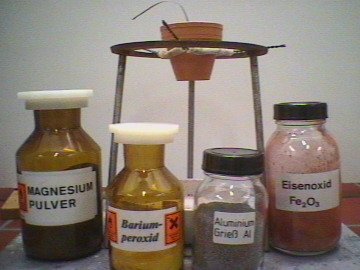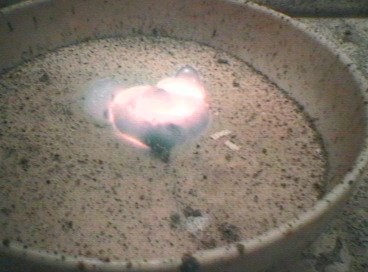



| 1. |  |
2. |  |
| Experimental setup | Combustion of the ignition mixture | ||
| 3. |  |
4. |  |
| Thermit® reaction begins; white hot liquid iron seeps out | Reaction product: elemental iron |
| Photo 1: | Experimental setup: A flowerpot with a single drainage hole is filled with a mixture of iron oxide (Fe2O3) and coarsely ground aluminum (reaction mixture: Thermit® mixture). This is covered with a mixture of magnesium and barium peroxide (BaO2) (ignition mixture). A strip of magnesium serves as a wick. A porcelain dish filled with sand is placed underneath. |
| Photo 2: | The magnesium-barium peroxide mixture is ignited by the burning magnesium ribbon. Magnesium oxide and barium oxide are produced in a strongly exothermic reaction according to:
BaO2 + Mg > BaO + MgO
The heat emitted by this reaction ignites the Thermit® mixture.
|
| Photos 3, 4: | Due to very high temperatures (up to 2400°C, reaction enthalpy: 852 kJ/mol) the reation of iron oxide with aluminum forms elemental iron, which seeps in liquid form out of the flower pot drainage hole:
Fe2O3 + 2 Al > 2 Fe + Al2O3
The molten iron is collected in the porcelain dish where it immediately hardens. An afterglow can be clearly seen.The Thermit® process is used to weld and join iron parts (such as iron tracks and street car tracks). A number of other metals can be obtained from their oxides by reduction with aluminum. |
| Exercise 4.4.13.1: Solution: |
The amount of heat energy released during a Thermit reaction is determined to be -661.1 kJ. Given a surplus of iron oxide, how many grams of alumninum were used during the reaction? |
| Exercise 4.4.13.2: Solution: |
How many grams of aluminum are necessary to raise the temperature of 200 g water from 20 °C to 80 °C? |